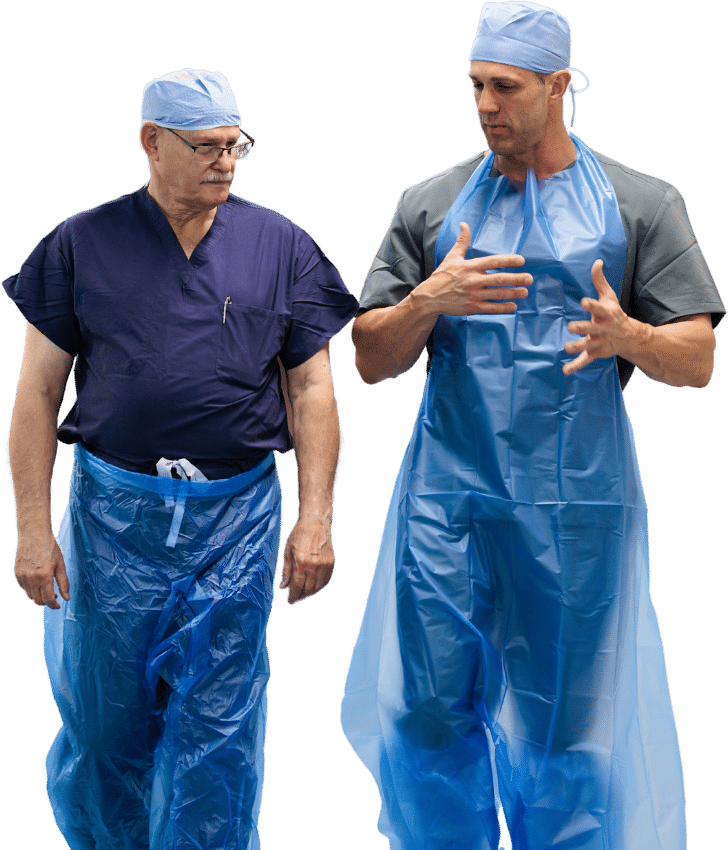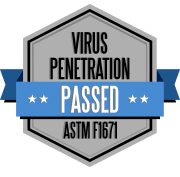Doctors, nurses and operating room staff who are present during surgeries are all at risk of fluid transfer in messy procedures. Protecting staff in sterile and non-sterile environments is a critical element of running a safe OR. While standardized PPE and scrubbing procedures prepare the sterile zone (waist up) to keep staff safe, protecting your medical team from fluid transfer from the waist down is often overlooked for high-volume fluid surgeries.
How Body Fluid Transfer Happens
Staff safety in the OR largely depends on creating a sterile environment and keeping the transfer of body fluids to a minimum. Not all surgeries are the same, however, and some have few fluid issues while others are extremely messy. This can lead to soggy shoes and dirty scrubs, or even a medical team left to spend the rest of their day in uncomfortable clothing.
A few high-risk fluid transfer examples include:
- Orthopedic Arthroscopy – Surgical fluids are pumped through the patient. The fluid often splashes and reaches the floor or makes contact with staff after exiting the patient.
- C-sections – The amniotic sack and other fluids are messy and have little to no containment.
- Cyst Procedures – Cysts are essentially fluid under pressure, and some surgeries are accompanied by excessive fluid contact with staff.
These are just a few of the common high-fluid contact surgical categories. The fluids are not always from the patient themselves, but rather involve surgical fluids pumped through the patient. Regardless, the fluids present the same risks, and protecting staff remains an absolute necessity.
Mitigating the Risk of Fluid Transfer
Everything above the waist is a focal point for protection and for good reason. The eyes, nose and mouth are at the greatest risk for fluid transfer, and they are protected by masks and surgical glasses. Head caps work to contain hair and prevent transfer to the patient, and they can also stop fluid splash from scalp contact.
Gowns and gloves are the next phases of protection. There are numerous categories and sizes for gloves. Not only does this equipment protect the surgeon and staff, but a proper fit is required to perform detailed maneuvers during surgeries.
Lastly, open wounds are an often overlooked risk factor for staff. Even a small cut elevates the risk of fluid transfer becoming a major problem. While the sterile zone is protected, the waist down is exposed, and this is especially problematic during messy surgeries.
Adding booties or knee-high coverings is an important consideration when fluids are splashing and pooling on the ground. Sloan Medical STA-DRI coverings have an AAMI Level 4 testing. This means they are impenetrable from even the smallest particles, and they offer the highest level of protection for the covered area.
Working on a Wet Floor
Safety measures in the operating room include things like procedures for handling and placing sharp objects, sound considerations, lighting for visibility, and more. Most of these are controllable safety measures that are accounted for before the surgery begins.
During surgeries, however, fluid that splashes and spills carries to the floor, where the sudden risk of slipping and falling is added to the list of safety concerns. This calls for proper traction while working in slippery conditions.
In the past, some surgeons have turned to rubber-style fishing boots, and they do work well. The boots are reusable, but sterilization is not required. That means the boots may be used for multiple surgeries across a long time period without proper cleaning. Also, the surgeons may use these boots, but nurses and support staff are typically limited to their work shoes. After a wet surgery, they may need to continue wearing those same shoes (uncomfortably) throughout the shift.
Bootie-style shoe coverings can help, and some have integrated traction. However, a bootie typically slides on the shoe, and the traction strip becomes useless when it’s not positioned directly beneath the sole. Many models of booties also shed particulates, making the post-op sterilization process more difficult.
Our STA-DRI line of booties and coverings is built with a unique non-slip material that provides constant traction on wet surfaces. Since the entire bootie uses non-slip material, rather than a single strip, traction is always delivered.
Additionally, the booties do not shed and will never contaminate other tools. The sterilization process is not compromised by flakes of paper and degrading materials. The STA-DRI design brings additional safety to the OR without adding layers of post-op sterilization.
Protect your operating room staff from fluid transfer and create a safe and stable environment with high-quality PPE. Our impenetrable coverings that provide traction on wet surfaces can shield doctors and staff against fluid transfer and prevent slip-and-falls without any additional sterilization concerns. Get in touch with Sloan Medical to learn more today.





